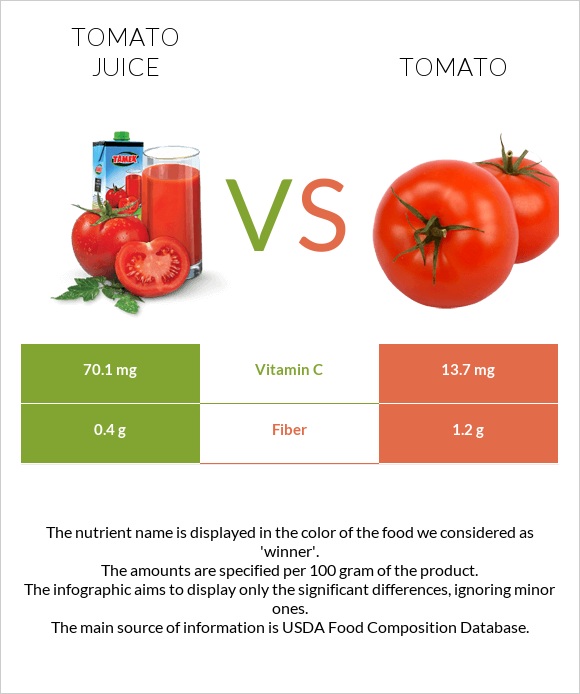Tomato juice vs. Tomato — In-Depth Nutrition Comparison
Compare
A recap on the differences between tomato juice and tomatoes
- Tomato juice is higher in vitamin C and vitamin B1, yet tomatoes are higher in vitamin A.
- Tomato juice covers your daily vitamin C needs 63% more than tomatoes.
- Tomato juice contains 3 times more vitamin B1 than tomatoes. While tomato juice contains 0.1mg of vitamin B1, tomatoes contain only 0.037mg.
Food varieties used in this article are Tomato juice, canned, without salt added and Tomatoes, red, ripe, raw, year round average.
Infographic

Infographic link
Mineral Comparison
Mineral comparison score is based on the number of minerals by which one or the other food is richer. The "coverage" charts below show how much of the daily needs can be covered by 300 grams of the food.
| Contains more IronIron | +44.4% |
| Contains more SeleniumSelenium | +∞% |
| Contains more CopperCopper | +40.5% |
| Contains more ZincZinc | +54.5% |
| Contains more PhosphorusPhosphorus | +26.3% |
| Contains less SodiumSodium | -50% |
| Contains more ManganeseManganese | +67.6% |
Vitamin Comparison
Vitamin comparison score is based on the number of vitamins by which one or the other food is richer. The "coverage" charts below show how much of the daily needs can be covered by 300 grams of the food.
| Contains more Vitamin CVitamin C | +411.7% |
| Contains more Vitamin B1Vitamin B1 | +170.3% |
| Contains more Vitamin B2Vitamin B2 | +310.5% |
| Contains more Vitamin B3Vitamin B3 | +13.3% |
| Contains more FolateFolate | +33.3% |
| Contains more Vitamin AVitamin A | +82.6% |
| Contains more Vitamin EVitamin E | +68.8% |
| Contains more Vitamin B6Vitamin B6 | +14.3% |
| Contains more Vitamin KVitamin K | +243.5% |
All nutrients comparison - raw data values
| Nutrient |  |
 |
DV% diff. |
| Vitamin C | 70.1mg | 13.7mg | 63% |
| Vitamin B1 | 0.1mg | 0.037mg | 5% |
| Vitamin B2 | 0.078mg | 0.019mg | 5% |
| Vitamin K | 2.3µg | 7.9µg | 5% |
| Fiber | 0.4g | 1.2g | 3% |
| Iron | 0.39mg | 0.27mg | 2% |
| Copper | 0.042mg | 0.059mg | 2% |
| Vitamin A | 23µg | 42µg | 2% |
| Manganese | 0.068mg | 0.114mg | 2% |
| Vitamin B5 | 0.089mg | 2% | |
| Potassium | 217mg | 237mg | 1% |
| Zinc | 0.11mg | 0.17mg | 1% |
| Phosphorus | 19mg | 24mg | 1% |
| Vitamin E | 0.32mg | 0.54mg | 1% |
| Selenium | 0.5µg | 0µg | 1% |
| Vitamin B6 | 0.07mg | 0.08mg | 1% |
| Folate | 20µg | 15µg | 1% |
| Calories | 17kcal | 18kcal | 0% |
| Protein | 0.85g | 0.88g | 0% |
| Fats | 0.29g | 0.2g | 0% |
| Net carbs | 3.13g | 2.69g | N/A |
| Carbs | 3.53g | 3.89g | 0% |
| Magnesium | 11mg | 11mg | 0% |
| Calcium | 10mg | 10mg | 0% |
| Sugar | 2.58g | 2.63g | N/A |
| Sodium | 10mg | 5mg | 0% |
| Vitamin B3 | 0.673mg | 0.594mg | 0% |
| Choline | 6.8mg | 6.7mg | 0% |
| Saturated fat | 0.019g | 0.028g | 0% |
| Monounsaturated fat | 0.005g | 0.031g | 0% |
| Polyunsaturated fat | 0.027g | 0.083g | 0% |
| Tryptophan | 0.006mg | 0.006mg | 0% |
| Threonine | 0.026mg | 0.027mg | 0% |
| Isoleucine | 0.017mg | 0.018mg | 0% |
| Leucine | 0.024mg | 0.025mg | 0% |
| Lysine | 0.026mg | 0.027mg | 0% |
| Methionine | 0.005mg | 0.006mg | 0% |
| Phenylalanine | 0.026mg | 0.027mg | 0% |
| Valine | 0.017mg | 0.018mg | 0% |
| Histidine | 0.014mg | 0.014mg | 0% |
| Fructose | 1.33g | 1.37g | 0% |
| Omega-3 - ALA | 0.005g | N/A | |
| Omega-6 - Linoleic acid | 0.022g | N/A |
Macronutrient Comparison
Macronutrient breakdown side-by-side comparison
Protein:
0.85 g
Fats:
0.29 g
Carbs:
3.53 g
Water:
94.24 g
Other:
1.09 g
Protein:
0.88 g
Fats:
0.2 g
Carbs:
3.89 g
Water:
94.52 g
Other:
0.51 g
| Contains more FatsFats | +45% |
| Contains more OtherOther | +113.7% |
| Contains more CarbsCarbs | +10.2% |
~equal in
Protein
~0.88g
~equal in
Water
~94.52g
Fat Type Comparison
Fat type breakdown side-by-side comparison
Saturated fat:
Sat. Fat
0.019 g
Monounsaturated fat:
Mono. Fat
0.005 g
Polyunsaturated fat:
Poly. Fat
0.027 g
Saturated fat:
Sat. Fat
0.028 g
Monounsaturated fat:
Mono. Fat
0.031 g
Polyunsaturated fat:
Poly. Fat
0.083 g
| Contains less Sat. FatSaturated fat | -32.1% |
| Contains more Mono. FatMonounsaturated fat | +520% |
| Contains more Poly. FatPolyunsaturated fat | +207.4% |
Carbohydrate type comparison
Carbohydrate type breakdown side-by-side comparison
Starch:
0 g
Sucrose:
0 g
Glucose:
1.25 g
Fructose:
1.33 g
Lactose:
0 g
Maltose:
0 g
Galactose:
0 g
Starch:
0 g
Sucrose:
0 g
Glucose:
1.25 g
Fructose:
1.37 g
Lactose:
0 g
Maltose:
0 g
Galactose:
0 g
~equal in
Starch
~0g
~equal in
Sucrose
~0g
~equal in
Glucose
~1.25g
~equal in
Fructose
~1.37g
~equal in
Lactose
~0g
~equal in
Maltose
~0g
~equal in
Galactose
~0g




